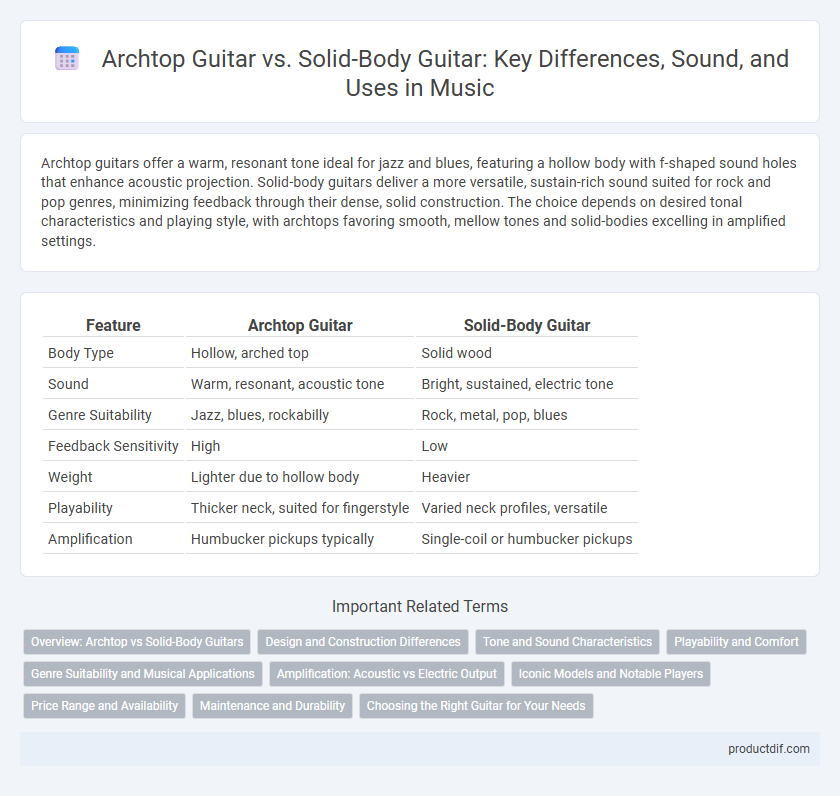Archtop guitars offer a warm, resonant tone ideal for jazz and blues, featuring a hollow body with f-shaped sound holes that enhance acoustic projection. Solid-body guitars deliver a more versatile, sustain-rich sound suited for rock and pop genres, minimizing feedback through their dense, solid construction. The choice depends on desired tonal characteristics and playing style, with archtops favoring smooth, mellow tones and solid-bodies excelling in amplified settings.
Table of Comparison
| Feature | Archtop Guitar | Solid-Body Guitar |
|---|---|---|
| Body Type | Hollow, arched top | Solid wood |
| Sound | Warm, resonant, acoustic tone | Bright, sustained, electric tone |
| Genre Suitability | Jazz, blues, rockabilly | Rock, metal, pop, blues |
| Feedback Sensitivity | High | Low |
| Weight | Lighter due to hollow body | Heavier |
| Playability | Thicker neck, suited for fingerstyle | Varied neck profiles, versatile |
| Amplification | Humbucker pickups typically | Single-coil or humbucker pickups |
Overview: Archtop vs Solid-Body Guitars
Archtop guitars feature a hollow body with a carved top and f-holes, delivering a warm, resonant tone ideal for jazz and blues styles. Solid-body guitars, made from a solid piece of wood, produce a brighter, more sustained sound with reduced feedback, making them popular in rock, metal, and pop genres. The choice between archtop and solid-body depends on the desired tonal qualities, playing style, and musical genre preferences.
Design and Construction Differences
Archtop guitars feature a hollow body with a carved top and back, often made from laminated wood, enhancing acoustic resonance and providing a warm, rich tone suited for jazz and blues. Solid-body guitars consist of a single solid piece of wood, typically alder or mahogany, designed to minimize feedback and amplify sustain, making them ideal for rock and heavy genres. The distinct construction affects weight, sound projection, and feedback handling, influencing the player's tonal preferences and performance style.
Tone and Sound Characteristics
Archtop guitars produce a warm, resonant tone with pronounced midrange frequencies, making them ideal for jazz and blues genres where clarity and acoustic feedback are valued. Solid-body guitars offer a sharper, more sustained sound with reduced feedback, favored in rock and metal for their powerful distortion and versatile tonal range. The hollow body of archtop guitars enhances natural resonance, while solid-body guitars rely on electronic amplification to shape their distinct sound characteristics.
Playability and Comfort
Archtop guitars feature a hollow body and a curved top, offering lighter weight and enhanced resonance that contributes to a comfortable playing experience during extended sessions. Solid-body guitars, with their dense construction, provide superior sustain but tend to be heavier, potentially affecting long-term comfort and ease of play. The neck profile and body contours of each guitar type also impact playability, with archtops generally favoring jazz styles requiring smooth finger transitions, while solid-body guitars accommodate diverse genres with faster, more aggressive playing techniques.
Genre Suitability and Musical Applications
Archtop guitars excel in jazz, blues, and swing due to their warm, resonant tones and enhanced acoustic projection, making them ideal for traditional and smooth musical styles. Solid-body guitars are favored in rock, metal, and pop genres for their sustain, feedback resistance, and versatility with effects, supporting aggressive and high-gain playing techniques. The choice between archtop and solid-body depends on desired tonal qualities and genre-specific performance needs.
Amplification: Acoustic vs Electric Output
Archtop guitars produce a warm, resonant acoustic output due to their hollow body construction, making them ideal for jazz and blues with natural amplification. Solid-body guitars rely on electronic pickups to convert string vibrations into electric signals, offering higher output and versatility across genres like rock and metal. The choice between archtop and solid-body guitars significantly impacts amplification style and tonal characteristics, influencing live performance and recording settings.
Iconic Models and Notable Players
The Gibson ES-175 and the Gretsch White Falcon stand out as iconic archtop guitars, famously played by jazz legends like Joe Pass and Chet Atkins. In contrast, solid-body guitars such as the Fender Stratocaster and Gibson Les Paul are staples in rock and blues, notably wielded by Jimi Hendrix and Jimmy Page. These models illustrate the distinct tonal and stylistic preferences defining archtop versus solid-body guitar use across musical genres.
Price Range and Availability
Archtop guitars typically range from $1,000 to $5,000, often favored by jazz musicians for their warm tone and craftsmanship, but they can be less readily available in mainstream music stores. Solid-body guitars are widely available across all price points, starting as low as $150 for beginner models and exceeding $4,000 for premium brands like Fender and Gibson. The broader availability and diverse pricing make solid-body guitars more accessible to a variety of players with different budgets.
Maintenance and Durability
Archtop guitars require regular maintenance due to their hollow body, which makes them more susceptible to humidity changes and potential top warping. Solid-body guitars offer enhanced durability and are less prone to environmental damage, making them ideal for rigorous touring and frequent use. Proper care for archtops includes humidity control and periodic adjustments, whereas solid-body guitars typically need only standard cleaning and string replacements.
Choosing the Right Guitar for Your Needs
Archtop guitars feature hollow bodies and carved tops that produce warm, resonant tones ideal for jazz and blues, while solid-body guitars offer sustained sound and noise reduction perfect for rock and heavier genres. Choosing the right guitar depends on your musical style, with archtops favoring clean, mellow sounds and solid-bodies excelling in distortion and gain handling. Consider factors like amplified tone, feedback sensitivity, and playability to match the instrument's characteristics to your specific performance and recording needs.
Archtop guitar vs solid-body guitar Infographic

 productdif.com
productdif.com